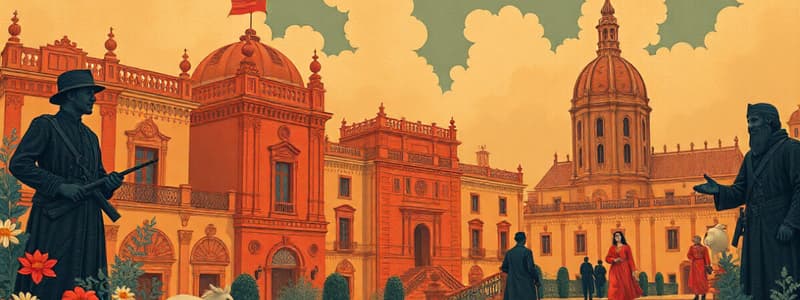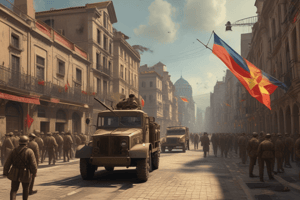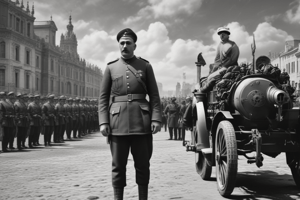Podcast
Questions and Answers
What was one of the principal characteristics of the Segunda República?
What was one of the principal characteristics of the Segunda República?
- Universal suffrage for men and women (correct)
- Monarchy with limited powers
- Censorship of media and expression
- State-controlled education only
Which reform aimed at the social rights during the Segunda República included marriage changes?
Which reform aimed at the social rights during the Segunda República included marriage changes?
- Civil marriage and divorce (correct)
- Legalizing polygamy
- Restricting marriage to economic classes
- Strengthening church marriages
What was a key issue that led to the paralysis of reforms after the 1933 elections?
What was a key issue that led to the paralysis of reforms after the 1933 elections?
- Increased support for anarchism
- Formation of a military junta
- Rise of socialist collaboration
- Victory of conservative forces (correct)
What significant event was triggered by the political issues of the Segunda República in July 1936?
What significant event was triggered by the political issues of the Segunda República in July 1936?
Who was the President of the República during the Segunda República?
Who was the President of the República during the Segunda República?
What was a significant consequence of the Spanish Civil War?
What was a significant consequence of the Spanish Civil War?
What major event occurred on July 18, 1936?
What major event occurred on July 18, 1936?
Which factor contributed to the rebel victory in the Spanish Civil War?
Which factor contributed to the rebel victory in the Spanish Civil War?
Which countries provided the rebel zone with significant foreign support during the Spanish Civil War?
Which countries provided the rebel zone with significant foreign support during the Spanish Civil War?
What was the outcome for Madrid during the Spanish Civil War?
What was the outcome for Madrid during the Spanish Civil War?
What was a key characteristic of the Autarquía period (1939-1959)?
What was a key characteristic of the Autarquía period (1939-1959)?
During which period did Spain experience increased tourist activity?
During which period did Spain experience increased tourist activity?
What was a political characteristic of the Desarrollismo period?
What was a political characteristic of the Desarrollismo period?
Which international alliance was Spain part of during World War II?
Which international alliance was Spain part of during World War II?
Which aspect of society was significantly impacted by the Franco dictatorship?
Which aspect of society was significantly impacted by the Franco dictatorship?
What is the primary function of the Legislative Branch in the Spanish government?
What is the primary function of the Legislative Branch in the Spanish government?
Which two chambers make up the Legislative Branch (Cortes Generales) in Spain?
Which two chambers make up the Legislative Branch (Cortes Generales) in Spain?
Where does the Judicial Branch of the Spanish government reside?
Where does the Judicial Branch of the Spanish government reside?
Which role does the King of Spain play in government institutions?
Which role does the King of Spain play in government institutions?
Who directs and enforces laws in the Spanish government?
Who directs and enforces laws in the Spanish government?
Who was appointed by Franco to be his successor in 1969?
Who was appointed by Franco to be his successor in 1969?
What significant event occurred in 1977 in the context of Spanish democracy?
What significant event occurred in 1977 in the context of Spanish democracy?
Which of the following was a key action taken by Adolfo Suárez during the Transition?
Which of the following was a key action taken by Adolfo Suárez during the Transition?
What was a significant issue during the initial period of Alfonso XIII's reign?
What was a significant issue during the initial period of Alfonso XIII's reign?
What was the outcome of the referendum held on December 6, 1978?
What was the outcome of the referendum held on December 6, 1978?
Since the arrival of democracy in Spain, how often have elections been held?
Since the arrival of democracy in Spain, how often have elections been held?
Which movement was attempted as a solution to Spain's crises during the reign of Alfonso XIII?
Which movement was attempted as a solution to Spain's crises during the reign of Alfonso XIII?
What event marked the beginning of General Primo de Rivera's dictatorship in 1923?
What event marked the beginning of General Primo de Rivera's dictatorship in 1923?
What was one outcome of Primo de Rivera's regime during 1923-1930?
What was one outcome of Primo de Rivera's regime during 1923-1930?
In what year did Alfonso XIII abdicate and leave the country?
In what year did Alfonso XIII abdicate and leave the country?
What was a major contributor to the political instability in Spain during Alfonso XIII's reign?
What was a major contributor to the political instability in Spain during Alfonso XIII's reign?
What did the 1931 municipal elections lead to?
What did the 1931 municipal elections lead to?
What significant social change occurred during the reign of Alfonso XIII?
What significant social change occurred during the reign of Alfonso XIII?
Flashcards
Legislative Branch
Legislative Branch
The branch of government responsible for creating laws.
Executive Branch
Executive Branch
The branch of government responsible for enforcing laws.
Judicial Branch
Judicial Branch
The branch of government responsible for interpreting and applying laws.
Tribunal Supremo
Tribunal Supremo
Signup and view all the flashcards
Tribunal Constitucional
Tribunal Constitucional
Signup and view all the flashcards
Autarquía
Autarquía
Signup and view all the flashcards
Desarrollismo
Desarrollismo
Signup and view all the flashcards
Franco's Dictatorship
Franco's Dictatorship
Signup and view all the flashcards
Spanish Civil War's Role
Spanish Civil War's Role
Signup and view all the flashcards
Impact of the Dictatorship
Impact of the Dictatorship
Signup and view all the flashcards
Spanish Civil War
Spanish Civil War
Signup and view all the flashcards
The Uprising
The Uprising
Signup and view all the flashcards
Rebellious Zone and Republican Zone
Rebellious Zone and Republican Zone
Signup and view all the flashcards
Factors Contributing to the Rebellion's Victory
Factors Contributing to the Rebellion's Victory
Signup and view all the flashcards
Weaknesses of the Republican Side
Weaknesses of the Republican Side
Signup and view all the flashcards
The Second Spanish Republic
The Second Spanish Republic
Signup and view all the flashcards
Social Reforms of the Second Republic
Social Reforms of the Second Republic
Signup and view all the flashcards
Agrarian Reform
Agrarian Reform
Signup and view all the flashcards
Evolution of the Second Republic
Evolution of the Second Republic
Signup and view all the flashcards
Regeneracionismo
Regeneracionismo
Signup and view all the flashcards
The Spanish Transition
The Spanish Transition
Signup and view all the flashcards
Negotiations and Consensus
Negotiations and Consensus
Signup and view all the flashcards
1977 Elections
1977 Elections
Signup and view all the flashcards
The 1978 Constitution
The 1978 Constitution
Signup and view all the flashcards
Recovered Rights
Recovered Rights
Signup and view all the flashcards
Reign of Alfonso XIII
Reign of Alfonso XIII
Signup and view all the flashcards
Caciquismo
Caciquismo
Signup and view all the flashcards
1923 Military Coup
1923 Military Coup
Signup and view all the flashcards
Primo de Rivera's Dictatorship
Primo de Rivera's Dictatorship
Signup and view all the flashcards
Republic Proclamation (1931)
Republic Proclamation (1931)
Signup and view all the flashcards
1898 Crisis
1898 Crisis
Signup and view all the flashcards
Post-WW1 Economic Boom
Post-WW1 Economic Boom
Signup and view all the flashcards




